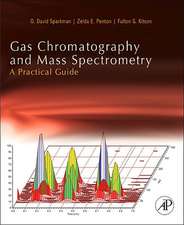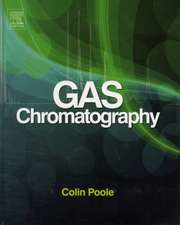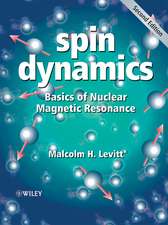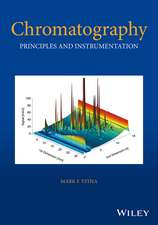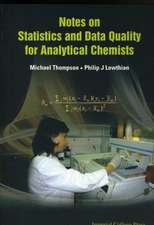Chemistry and Physics of Solid Surfaces VIII: Springer Series in Surface Sciences, cartea 22
Editat de Ralf Vanselow, Russell Hoween Limba Engleză Paperback – 6 dec 2011
Din seria Springer Series in Surface Sciences
- 18%
 Preț: 1131.25 lei
Preț: 1131.25 lei - 15%
 Preț: 654.77 lei
Preț: 654.77 lei - 18%
 Preț: 1113.09 lei
Preț: 1113.09 lei -
 Preț: 390.63 lei
Preț: 390.63 lei -
 Preț: 407.98 lei
Preț: 407.98 lei - 15%
 Preț: 657.57 lei
Preț: 657.57 lei - 15%
 Preț: 636.63 lei
Preț: 636.63 lei - 15%
 Preț: 641.20 lei
Preț: 641.20 lei - 15%
 Preț: 651.19 lei
Preț: 651.19 lei - 15%
 Preț: 645.60 lei
Preț: 645.60 lei - 15%
 Preț: 632.70 lei
Preț: 632.70 lei - 15%
 Preț: 640.24 lei
Preț: 640.24 lei - 15%
 Preț: 646.11 lei
Preț: 646.11 lei -
 Preț: 397.38 lei
Preț: 397.38 lei -
 Preț: 386.22 lei
Preț: 386.22 lei -
 Preț: 387.75 lei
Preț: 387.75 lei -
 Preț: 389.31 lei
Preț: 389.31 lei -
 Preț: 406.42 lei
Preț: 406.42 lei - 18%
 Preț: 1011.14 lei
Preț: 1011.14 lei - 18%
 Preț: 2100.88 lei
Preț: 2100.88 lei -
 Preț: 398.35 lei
Preț: 398.35 lei -
 Preț: 392.21 lei
Preț: 392.21 lei -
 Preț: 389.88 lei
Preț: 389.88 lei - 15%
 Preț: 646.43 lei
Preț: 646.43 lei - 15%
 Preț: 643.16 lei
Preț: 643.16 lei - 15%
 Preț: 643.65 lei
Preț: 643.65 lei - 18%
 Preț: 948.79 lei
Preț: 948.79 lei - 15%
 Preț: 641.03 lei
Preț: 641.03 lei - 15%
 Preț: 640.55 lei
Preț: 640.55 lei - 15%
 Preț: 640.71 lei
Preț: 640.71 lei - 18%
 Preț: 952.72 lei
Preț: 952.72 lei - 18%
 Preț: 955.08 lei
Preț: 955.08 lei - 15%
 Preț: 648.42 lei
Preț: 648.42 lei - 15%
 Preț: 641.03 lei
Preț: 641.03 lei - 18%
 Preț: 1000.42 lei
Preț: 1000.42 lei - 18%
 Preț: 952.57 lei
Preț: 952.57 lei - 18%
 Preț: 1001.02 lei
Preț: 1001.02 lei
Preț: 399.12 lei
Nou
Puncte Express: 599
Preț estimativ în valută:
76.37€ • 79.95$ • 63.19£
76.37€ • 79.95$ • 63.19£
Carte tipărită la comandă
Livrare economică 05-19 aprilie
Preluare comenzi: 021 569.72.76
Specificații
ISBN-13: 9783642757648
ISBN-10: 3642757642
Pagini: 484
Ilustrații: XV, 464 p.
Dimensiuni: 155 x 235 x 25 mm
Greutate: 0.68 kg
Ediția:Softcover reprint of the original 1st ed. 1990
Editura: Springer Berlin, Heidelberg
Colecția Springer
Seria Springer Series in Surface Sciences
Locul publicării:Berlin, Heidelberg, Germany
ISBN-10: 3642757642
Pagini: 484
Ilustrații: XV, 464 p.
Dimensiuni: 155 x 235 x 25 mm
Greutate: 0.68 kg
Ediția:Softcover reprint of the original 1st ed. 1990
Editura: Springer Berlin, Heidelberg
Colecția Springer
Seria Springer Series in Surface Sciences
Locul publicării:Berlin, Heidelberg, Germany
Public țintă
ResearchCuprins
1. Reactivity of Surfaces.- 1.1 Chemisorbed Phases—Alterations of the Substrate Bonds.- 1.2 Chemical Transformation—Alteration of the Adsorbate Bonds.- 1.3 Nonlinear Dynamics in Surface Reactions.- 1.4 Conclusion.- References.- 2. New Mechanisms for the Activation and Desorption of Molecules at Surfaces.- 2.1 Translational Activation of CH4.- 2.2 Collision Induced Dissociative Chemisorption and Collision Induced Desorption of CH4.- 2.3 New Methods for Activation: New Syntheses.- References.- 3. Photochemistry at Adsorbate-Metal Interfaces: Intra-adsorbate Bond Breaking.- 3.1 General Considerations.- 3.2 Experimental Considerations.- 3.3 Examples.- 3.4 Prospects.- References.- 4. Desorption Induced by Electronic Transitions.- 4.1 Mechanisms of DIET.- 4.2 Experimental Procedures for Positive and Negative Ion ESDIAD.- 4.3 DIET Studies of a Model System: PF3 on Ru{0001}.- 4.4 Summary and Conclusions.- References.- 5. Transition Metal Clusters and Isolated Atoms in Zeolite Cages.- 5.1 Preparation of Encaged Particles.- 5.2 Thermodynamic “Driving Forces” Favoring Locations and Particle Morphology.- 5.3 Mechanisms of Metal Particle Formation.- 5.4 Identification of Isolated Atoms and Electron Deficient Particles.- 5.5 Formation of Bimetallic Particles.- 5.6 Summary and Conclusions.- References.- 6. Studies of Bonding and Reaction on Metal Surfaces Using Second-Harmonic and Sum-Frequency Generation.- 6.1 Second-Harmonic Generation.- 6.2 Sum-Frequency Generation.- References.- 7. Surface Physics and Chemistry in High Electric Fields.- 7.1 Electric Fields at Metal Surfaces.- 7.2 Dispersion and Polarization Forces.- 7.3 Field-Induced Chemisorption.- 7.4 Field Evaporation.- 7.5 Thermal Field Desorption.- 7.6 Field-Induced Chemistry.- 7.7 Concluding Remarks.- References.- 8.Chaos in Surface Dynamics.- 8.1 Concepts in Chaos.- 8.2 Examples.- 8.3 Period Doubling.- 8.4 Hamiltonian Systems.- References.- 9. Ten Years of Low Energy Positron Diffraction.- 9.1 Low-Energy Electron Diffraction.- 9.2 The First LEPD Experiments (1979).- 9.3 Brightness Enhancement.- 9.4 Surface Structure Determinations with Modern LEPD: CdSe{1010} and CdSe{1120}.- 9.5 Positron Diffraction at Very Low Energy.- 9.6 Conclusions.- References.- 10. Time-of-Flight Scattering and Recoiling Spectrometry (TOF-SARS) for Surface Analysis.- 10.1 Historical Review.- 10.2 Experimental Method.- 10.3 Examples of Experimental Results.- 10.4 Summary.- References.- 11. Scanning Electron Microscopy with Polarization Analysis: Studies of Magnetic Microstructure.- 11.1 Spin Polarization of Secondary Electrons.- 11.2 Experimental.- 11.3 SEMPA Measurement Examples.- 11.4 Summary and Future Directions.- References.- 12. Low Energy Electron Microscopy.- 12.1 Fundamentals of LEEM.- 12.2 LEEM Studies of Clean Surfaces.- 12.3 LEEM Studies of Surface Layers.- 12.4 Outlook.- 12.5 Summary.- References.- 13. Atomic Scale Surface Characterization with Photoemission of Adsorbed Xenon (PAX).- 13.1 Introduction.- 13.2 Principles of the PAX-Technique.- 13.3 Selected Case Studies of Metallic Surfaces.- 13.4 Summary and Implications.- References.- 14. Theoretical Aspects of Scanning Tunneling Microscopy.- 14.1 General Tunneling Theory.- 14.2 STM Images and their Interpretation.- 14.3 Spectroscopy.- 14.4 Mechanical Interactions Between Tip and Sample.- 14.5 Conclusion.- References.- 15. Proximal Probes: Techniques for Measuring at the Nanometer Scale.- 15.1 Proximal Probes.- 15.2 Nanoscale Fabrication Using Proximal Probes.- 15.3 Conclusion.- References.- 16. Studying Surface Chemistry Atom-by-Atom Using theScanning Tunneling Microscope.- 16.1 Topography and Spectroscopy with the STM.- 16.2 Imaging Semiconductor Surface Chemistry Atom-by-Atom Using the STM.- 16.3 The Structure of the Si{111}-7 × 7 Surface.- 16.4 Site-Selective Reactions of Si{111}-7 × 7.- 16.5 Molecular Adsorption on Si{111}-7 × 7.- 16.6 Reactions That Involve Extensive Atomic Rearrangements.- 16.7 Doping Effects on Silicon Surface Chemistry.- 16.8 Conclusions and Prospects for the Future.- References.- 17. Bonding and Structure on Semiconductor Surfaces.- 17.1 Basic Mechanism Driving Surface Reconstruction.- 17.2 The Geometric and Electronic Structures of GaAs{110}.- 17.3 The GaAs{111}(2 × 2) Surface Reconstruction.- 17.4 Structure of the Si{111}7 × 7 Surface.- 17.5 The Ge{111} c(2 × 8) Reconstruction.- 17.6 Summary.- References.- 18. Tribology at the Atomic Scale.- 18.1 Concepts in Classical Tribology.- 18.2 Experimental Approaches.- 18.3 Theoretical Descriptions of Tribology.- 18.4 Summary and Future Directions.- References.- of Chemistry and Physics of Solid Surfaces IV (Springer Series in Chemical Physics, Vol. 20).- of Chemistry and Physics of Solid Surfaces V (Springer Series in Chemical Physics, Vol. 35).- of Chemistry and Physics of Solid Surfaces VI (Springer Series in Surface Sciences, Vol. 5).- of Chemistry and Physics of Solid Surfaces VII (Springer Series in Surface Sciences, Vol. 10).

